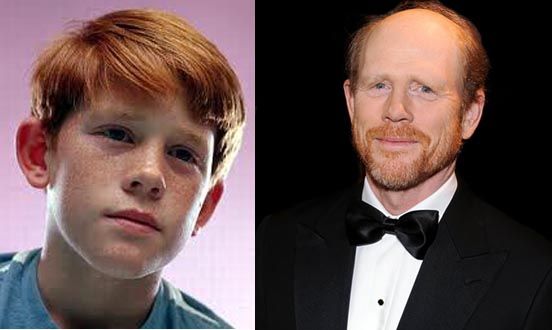Master of Biographical Films: Who is Ron Howard?
Oscar-winning director Ron Howard's Hollywood career actually began as an actor in the 1960s. Ron Howard owes his greatest success to biographical productions such as A Beautiful Mind, Frost/Nixon, and Rush.

Born in Oklahoma on March 1, 1954, Ronald William Howard was the child of an actor family. His father, Rance Howard, had the opportunity to realize his youthful dreams at the University of Oklahoma and studied theater. His mother, Jean, also graduated from an acting school in New York. This being the case, little Ron found himself in front of the camera when he was only 18 months old.
Although 1955's "The Frontier Women" was Howard's first film, his first appearance in a prominent role came four years later with the political drama "The Journey". Howard, who became one of the popular child stars after this role, appeared in many feature films such as "The Music Man" and "The Courtship of Eddie's Father" (1962).
In an interview published in "The Detroit News" in November 1966, Howard said that the director threatened to beat him if he cried during rehearsals for a movie he starred in when he was 6 years old. His most important protector during this process was his father, who made great efforts to protect him from the exploitation of the producers.
It was this role that brought fame to Howard, who played the role of Sheriff Andy Taylor's son, Opie, on "The Andy Griffith Show" between 1960 and 1968. Although many child actors who took part in similar productions were forgotten in the following years, Ron successfully survived this process and continued his acting career regularly in the following years. The actor, who appeared in front of the camera with Henry Fonda in the television series "The Smith Family" in 1971, did not hesitate to take risks to improve himself creatively, thanks in part to Fonda's encouragement.
Following his role in George Lucas's film "American Graffiti" in 1973, he appeared before the audience as the young American Richie Cunningham in the new episodes of the popular TV series of the 1950s, "Happy Days". Howard, who did not neglect cinema while working on TV series, stood out among the films he starred in during those years, the 1976 film "The Shootist", which also starred John Wayne.
Howard, who was nominated for a "Golden Globe" for his role in the film, thought it was time to realize his directorial dream. In 1976, Roger Corman, with whom he worked, gave Howard the direction of "Grand Theft Auto", which he produced, allowing him to realize this dream. (1977)
Although this film cannot be described as a masterpiece, it won the appreciation of moviegoers thanks to its exciting fast-paced action scenes. After the low-budget "Grand Theft Auto", this red-headed, cute child star of the past, whose face was covered in freckles, started to produce works that made him one of the leading directors of today. After leaving "Happy Days" in 1980, he directed Bette Davis in another television movie, "Skyward", and gained Davis's appreciation for his directing talent.
Howard's first hit film was the 1982 black comedy "Nightshift." This was his first work with producer Brian Grazer, with whom he would later collaborate on many films. This partnership would make Howard and Grazer business partners in the production company "Imagine Films Entertainment", which they founded in 1985.
Howard solidified his place in Hollywood with "Splash", which he shot in 1984. The film, starring Tom Hanks and Darryl Hannah, was met with great acclaim. This film was followed by 1985's "Cocoon". The director, who made "Parenthood" in 1989, experienced a decline in his career because the high-budget films he shot in the early 90s, such as "Backdraft" (1991) and "Far and Away" (1992), were not appreciated by the audience.
This situation did not last long and the director made a rapid breakthrough with 1993's "Apollo 13". The film, in which science, human curiosity, and fascinating special effects are melted in a perfect melting pot, achieved great success internationally and was nominated for an Oscar in 9 categories. ( “Apollo 13” was awarded the Oscar for “Best Sound” and “Best Editing”.) This film also brought a “Director's Guild Association” award to its director and was named after John Ford, Billy Wilder, George Cukor, and Francis Ford. It enabled him to be counted among directors like Coppola.
Howard, who stepped into the world of thrillers in 1996 with "Ransom" starring Mel Gibson, produced films such as "Inventing the Abbots" and "Beyond the Mat" and some television series for the next 3 years, and then in 1999 he started producing "Ed". He sat in the director's chair again with "TV".
Although the film received positive scores from most critics and was appreciated by the audience, its success was overshadowed when it started to be compared to Jim Carrey's "The Truman Show", which was released on the same dates.
He collaborated with Carrey, the multi-faced actor of the "Truman Show", in his next film, "How the Grinch Stole Christmas", which was adapted for the big screen from Theodore Geisel's classic New Year's story. Due to its complex sets, costumes, and Carrey's stunning Grinch performance, the film was viewed by many viewers as an overly bloated version of the beloved children's classic that inspired it.
After this film, Howard returned to the world of reality with his next work, "A Beautiful Mind", inspired by the life of Nobel Prize-winning genius John Forbes Nash Jr. The film, starring Russell Crowe and Jennifer Connelly, presented a visual expression of the disease by showing the development process and stages of paranoid schizophrenia.
"A Beautiful Mind", which was nominated in 8 categories for the 2002 Oscars, won the Oscar statuette in the categories of "Best Film", "Best Director", "Best Supporting Actress" and "Best Screenplay Adaptation".
